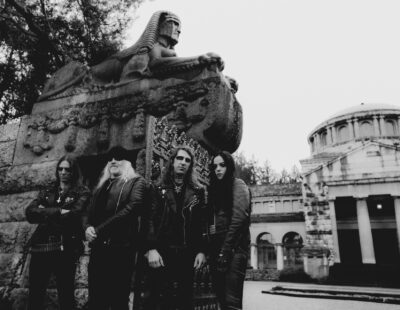Welcome to the first installment of VERSUS, an online segment where we’ll stream exclusive tracks from new records that have piqued our interest, head to head, and let you, dear reader, referee the fight in the comments section. To sweeten the deal, the commenter who makes the most persuasive case for his or her preferred record will win themselves a little swag package.
Our first face off is between the awesome Swedish grind trio Afgrund — currently inveighing mightily against the Age of Dumb — and Church of Misery, a fuzzed-up doom metal band featuring Stevo from Impetigo whose uber-excellent 1993 debut Minstrel of Mourning is only now seeing the light of day thanks to Razorback Records. (Note: This Church is not to be confused with the latter day saints signed to Metal Blade.)
We asked each band for a little background info on the albums/tracks they graciously provided. True to form, Afgrund kept things short and (bitter)sweet:
The Age Of Dumb is the epoch we’re living in, where humanity ignores its own mistakes and where politics, enviromental devastation and alienation have reached points of no return. “Carniwars” [is about] the systematic exploitation of animals for food and goods in modern day carnist societies is an act of war on nature. “H.A.A.R.P.Y” — Quasi-sci-fi consequences of the High-frequency Active Auroral Research Program.

And now enjoy Church of Misery’s “Old Man Tree” with commentary from Stevo below:
It may sound strange, but the concept of the lyrics for the song came from a dream I had as a very young child, resurrected in a reminiscence many years later. The protagonist is a Druid-type member of an ages-old sect who is confronting the “Death of Nature” in today’s world, against a backdrop of ancient knowledge and understanding. The concept of all of the Church of Misery songs were, indeed, odes to death and love letters to the passage of those close to us and how we are dealing with their demise as living beings…with that in mind, one can visualize how the prayer of the Druid in “Old Man Tree” aligns with this theme. The protagonist has accepted the fact that the ancient beliefs his brethren built their discipline upon no longer bear any fruit, and that the complex relationship of mankind and nature has, indeed, perished…his prayer is a final epitaph to the ‘old man tree,’ the patriarchal figurehead of his order’s fundamental beliefs, and his final words to the deity to whom he and his ancestors have devoted their spiritual lives to.
Brett originally submitted excellent lyrics for this song, not having known of my original concept beforehand. I hated to turn them down, but my thoughts on this were burning so brightly I needed to excorsize them to music before it was too late.
The music is a phoenetical representation of the lyrical prayer itself, you can hear elements of structure, pattern, and stanzas throughout the composition; the opening riff (invocation) repeated an modified throughout in the format of a more traditional “liturgy of the hours” with psalms interspersed, and ending in a benediction which completes the phrase. The bass solo/keyboard interlude is a meditative section; the ensuing guitar solo/percussion call and response is a responsorial psalm that follows the meditation. Music really is prayer!






